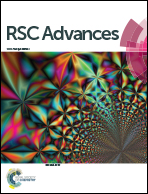A pyrene thiazole conjugate as a ratiometric chemosensor with high selectivity and sensitivity for tin (Sn4+) and its application in imaging live cells†
Abstract
A new pyrene thiazole conjugate (PTC) amine fluoroionophore was synthesized and characterized. The single crystal XRD structure of PTC has been established. The fluoroionophore PTC showed selectivity toward Sn4+ by switch on ratiometric fluorescence among the 16 metal ions studied in HEPES buffer medium with a detection limit of 6.93 μM. The interaction of Sn4+ with PTC has been further supported by absorption studies, and the stoichiometry of the complex formed (2 : 1) has been established on the basis of fluorescence and ESI-MS. Competitive ion titrations carried out reveal that the Sn4+ can be detected even in the presence of other metal ions of bio-importance. Moreover, the utility of the fluoroionophore PTC in showing the tin recognition in live cells has also been demonstrated using Vero 76 cells as monitored by fluorescence imaging. The tin complex of PTC was isolated, and the structure and electronic properties of [PTC–Sn] has been established by DFT and TDDFT calculations. The isolated tin complex [PTC–Sn] has been used as a molecular tool for the recognition of anions on the basis of their binding affinities toward Sn4+. [PTC–Sn] was found to be sensitive and selective toward sulphide ions among the other 12 anions studied. The selectivity has been shown on the basis of the changes observed in the emission and absorption spectral studies through the removal of Sn4+ from [PTC–Sn] by S2−.


 Please wait while we load your content...
Please wait while we load your content...